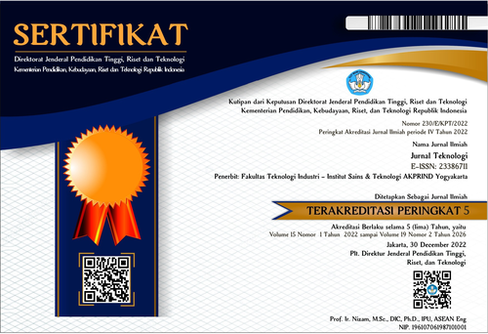Penggunaan Analytical Hierarchy Process dan Analytic Network Process dalam Menentukan Supplier Bahan Baku
DOI:
https://doi.org/10.34151/jurtek.v17i1.4684Keywords:
Analytical Hierarchy Process , Analytic Network Process, SupplierAbstract
Industry player, navigates the competitive convection business by strategically selecting raw material suppliers, with a focus on fabric. Employing the Analytical Hierarchy Process (AHP), a decision analysis method by Thomas L. Saaty, the company evaluates criteria such as price, quality, delivery, service, and location. In parallel, the Analytic Network Process (ANP), a more intricate method by Saaty, is utilized to account for reciprocal relationships within decision-making hierarchies. The company evaluates three alternative fabric suppliers: Kumala Textile, PT Kaha Tex, and PT Ada Tex. AHP calculations assign priority values – Kumala Textile at 0.381187, PT Kaha Tex at 0.470966, and PT Ada Tex at 0.073924. Concurrently, ANP prioritizes alternatives differently: Kumala Textile at 0.315383, PT Kaha Tex at 0.565728, and PT Ada Tex at 0.118889. Considering the results, PT Kaha Tex emerges as the most optimal raw material supplier with a dual-method endorsement. Kumala Textile secures the second recommendation, while PT Ada Tex takes the third spot. Selection criteria for fabric raw material suppliers encompass price, quality, delivery, service, and location. Grounded in prioritization values and criterion relationships, the comprehensive recommendation is in favor of PT Kaha Tex as the most optimal fabric raw material supplier.
Downloads
References
Adniyah, N. (2021). Analisis Pemilihan Supplier Bahan Baku Kain Kasur Dengan Menggunakan Metode Decision Making Trial and Evaluation Labotary (DEMATEL) dan Analytic Network Process (ANP) (Doctoral dissertation, Universitas Muhammadiyah Gresik).
Azhar, Z. (2020). Penerapan Metode Analytical Hierarchy Process dalam Pemilihan Bibit Jagung Unggul. JURTEKSI (Jurnal Teknologi dan Sistem Informasi), 6(2), 145-154.
Darmawan, Dwi Putra. (2018). Analytic Network Process. Yogyakarta: Expert.
Faturrahman, M. A., & Yustanti, W. (2020). Analisis Pemilihan Aplikasi Opensource ERP terhadap UKM Menggunakan Metode Kombinasi ANP dan PROMETHEE. Journal of Informatics and Computer Science (JINACS), 1(03), 122-127.
Giannakis, M., Dubey, R., Vlachos, I., & Ju, Y. (2020). Supplier sustainability performance evaluation using the analytic network process. Journal of cleaner production, 247, 119439.
Li, M., Wang, H., Wang, D., Shao, Z., & He, S. (2020). Risk assessment of gas explosion in coal mines based on fuzzy AHP and bayesian network. Process Safety and Environmental Protection, 135, 207-218.
Oktaviani, A., Wijayanto, D., & Prima, F. (2019). Penentuan Supplier Terbaik Menggunakan Metode Analytic Network Process (ANP). Jurnal Teknik Industri, Fakultas Teknik, Universitas Tanjungpura, 51–57
Puspitasari, N. B., & Yancadianti, K. H. (2016). Analisa Pemilihan Supplier Ramah Lingkungan Dengan Metode Analytical Network Process (ANP) Pada PT Kimia Farma Plant Semarang. Jurnal Teknik Industri, 11(1), 1-8.
Ramadhon, R. B., Wisnubroto, P., & Simanjuntak, R. A. (2021). Analisis Pemilihan Supplier Bahan Baku Menggunakan Metode Ahp (Analytical Hierarchy Process) Dan Topsis (Technique For Order Preference By Similarity To Ideal Solution) Pada Rockmantic Store Konveksi. Jurnal Rekavasi, 9(1), 54-64.
Saaty, T. L., & Ozdemir, M. S. (2021). The Encyclicon-Volume 1: A dictionary of decisions with dependence and feedback based on the analytic network process. RWS Publications.
Yusuf, M. (2017). Strategi Proses Transisi Dari Metode Six Sigma ke DFSS (Design For Six Sigma) Menggunakan Aplikasi AHP (Analytical Hierarchy Process). Jurnal Teknologi, 10(1), 40–46.
Downloads
Published
How to Cite
Issue
Section
License
Copyright (c) 2024 Cyrilla Indri Parwati

This work is licensed under a Creative Commons Attribution-ShareAlike 4.0 International License.
Jurnal Teknologi provides immediate open access to its content in order of making research freely available to the public to support a global exchange of knowledge. All articles published in this journal are free for everyone to read and download, under licence CC BY SA.
Benefits of open access for the author, include:
- Free access for all users worldwide.
- Authors retain copyright to their work.
- Increased visibility and readership.
- No spatial constraints.




















